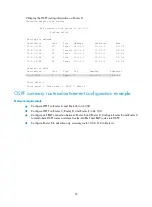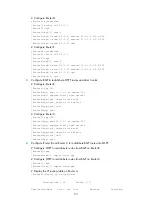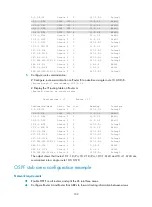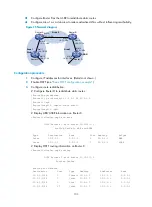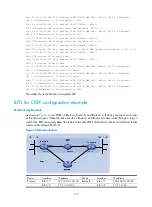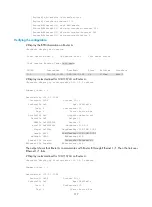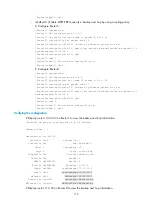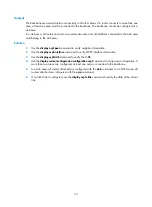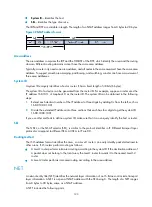
112
# Configure Router C.
<RouterC> system-view
[RouterC] ospf 1 router-id 3.3.3.3
[RouterC-ospf-1] area 1
[RouterC-ospf-1-area-0.0.0.1] network 10.2.1.0 0.0.0.255
[RouterC-ospf-1-area-0.0.0.1] quit
[RouterC-ospf-1] area 2
[RouterC–ospf-1-area-0.0.0.2] network 10.3.1.0 0.0.0.255
[RouterC–ospf-1-area-0.0.0.2] quit
[RouterC-ospf-1] quit
# Configure Router D.
<RouterD> system-view
[RouterD] ospf 1 router-id 4.4.4.4
[RouterD-ospf-1] area 2
[RouterD-ospf-1-area-0.0.0.2] network 10.3.1.0 0.0.0.255
[RouterD-ospf-1-area-0.0.0.2] quit
# Display OSPF routing information on Router B.
[RouterB] display ospf routing
OSPF Process 1 with Router ID 2.2.2.2
Routing Tables
Routing for Network
Destination Cost Type NextHop AdvRouter Area
10.2.1.0/24 2 Transit 10.2.1.1 3.3.3.3 0.0.0.1
10.1.1.0/24 2 Transit 10.1.1.2 2.2.2.2 0.0.0.0
Total Nets: 2
Intra Area: 2 Inter Area: 0 ASE: 0 NSSA: 0
Area 0 has no direct connection to Area 2, so the OSPF routing table of Router B has no route to
Area 2.
3.
Configure a virtual link:
# Configure Router B.
[RouterB] ospf
[RouterB-ospf-1] area 1
[RouterB-ospf-1-area-0.0.0.1] vlink-peer 3.3.3.3
[RouterB-ospf-1-area-0.0.0.1] quit
[RouterB-ospf-1] quit
# Configure Router C.
[RouterC] ospf
[RouterC-ospf-1] area 1
[RouterC-ospf-1-area-0.0.0.1] vlink-peer 2.2.2.2
[RouterC-ospf-1-area-0.0.0.1] quit
# Display OSPF routing information on Router B.
[RouterB] display ospf routing
OSPF Process 1 with Router ID 2.2.2.2
Routing Tables


